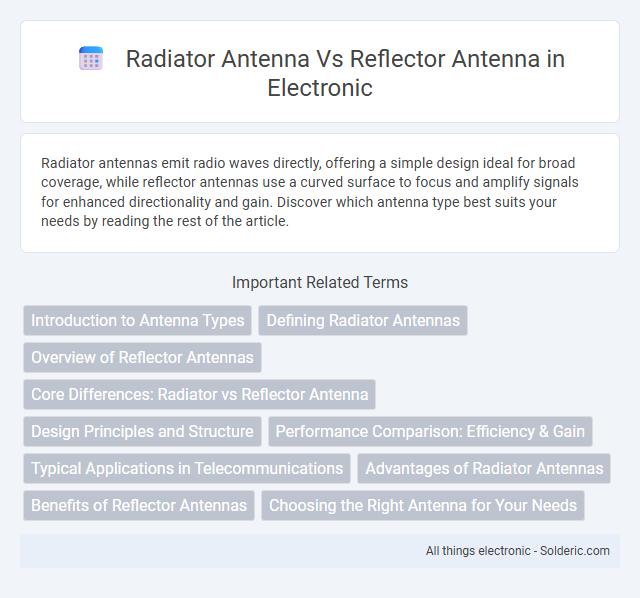Radiator antennas emit radio waves directly, offering a simple design ideal for broad coverage, while reflector antennas use a curved surface to focus and amplify signals for enhanced directionality and gain. Discover which antenna type best suits your needs by reading the rest of the article.
Comparison Table
| Feature | Radiator Antenna | Reflector Antenna |
|---|---|---|
| Definition | Primary source emitting radio waves directly | Uses a reflector to focus and direct radio waves |
| Typical Types | Dipole, Monopole, Loop antennas | Parabolic dish, Corner reflector antennas |
| Radiation Pattern | Omnidirectional or broad directional | Highly directional with focused beam |
| Gain | Low to moderate gain (typically 2-9 dBi) | High gain (up to 30+ dBi) |
| Applications | Broadcasting, mobile communication, simple wireless links | Satellite communication, radar, point-to-point links |
| Size and Complexity | Simple, compact design | Large, complex reflector structure |
| Frequency Range | Wide frequency range depending on design | Typically used at higher frequencies (microwave and above) |
| Cost | Lower cost, easy to manufacture | Higher cost due to precision reflector and structure |
Introduction to Antenna Types
Radiator antennas primarily emit electromagnetic waves directly through their conductive elements, making them ideal for broad coverage in communication systems. Reflector antennas use a parabolic or flat surface to reflect and focus signals, enhancing gain and directivity for long-distance or point-to-point transmissions. Understanding these fundamental differences is critical for selecting antennas based on application requirements such as range, coverage, and signal strength.
Defining Radiator Antennas
Radiator antennas, also known as driven antennas, generate electromagnetic waves by converting electrical signals directly into radio waves through their conductive elements, such as dipoles or monopoles. Unlike reflector antennas, which rely on a primary radiator combined with a reflective surface to focus and direct signals, radiator antennas emit signals omnidirectionally or with specific radiation patterns determined by their physical structure. Key examples of radiator antennas include half-wave dipoles, monopoles, and patch antennas, widely used in wireless communication and broadcasting applications.
Overview of Reflector Antennas
Reflector antennas use a curved surface, typically parabolic, to direct radio waves into a concentrated beam, enhancing signal strength and gain compared to radiator antennas. Their design allows for higher directivity and efficiency, making them ideal for long-distance communication and satellite applications. Your choice between radiator and reflector antennas should consider the need for focused signal transmission versus broader coverage.
Core Differences: Radiator vs Reflector Antenna
Radiator antennas transmit and receive electromagnetic waves directly by converting electrical signals into radio waves, serving as the primary source of radiation. Reflector antennas use a reflective surface, such as a parabolic dish, to focus and direct the radio waves emitted by a separate radiator element, enhancing signal strength and directivity. The core difference lies in the radiator antenna's role as the emitter versus the reflector antenna's function to concentrate and redirect signals for improved gain and beamwidth control.
Design Principles and Structure
Radiator antennas operate by directly converting RF energy into electromagnetic waves through a radiating element, typically a dipole or monopole, structured for efficient wave emission. Reflector antennas, on the other hand, focus electromagnetic waves using a parabolic or flat reflective surface, directing energy toward a focal radiator or receiving element for enhanced gain and directivity. Your choice depends on the desired directionality and gain, with radiator antennas favoring simple omnidirectional coverage and reflector antennas excelling in high-gain, directional applications.
Performance Comparison: Efficiency & Gain
Radiator antennas typically offer moderate efficiency and gain, making them suitable for general applications where size and simplicity are prioritized. Reflector antennas enhance performance by focusing radio waves, resulting in higher gain and improved efficiency, ideal for long-distance communication and precision targeting. You benefit from selecting a reflector antenna when maximizing signal strength and directional accuracy is critical.
Typical Applications in Telecommunications
Radiator antennas are commonly used in mobile and portable telecommunications devices due to their compact size and omnidirectional radiation patterns, making them ideal for cellular phones, walkie-talkies, and wireless routers. Reflector antennas, featuring parabolic dishes or corner reflectors, are preferred in satellite communications, radar systems, and point-to-point microwave links for their high gain and focused directional beams. The choice between radiator and reflector antennas depends on application-specific requirements such as range, frequency, and radiation pattern in telecommunications networks.
Advantages of Radiator Antennas
Radiator antennas offer the advantage of simpler design and easier installation compared to reflector antennas, making them ideal for compact and cost-effective applications. They provide omnidirectional radiation patterns, ensuring consistent signal coverage in all directions without the need for mechanical adjustments. Radiator antennas also typically have lower wind resistance and weight, enhancing durability and suitability for portable or mobile communication systems.
Benefits of Reflector Antennas
Reflector antennas offer significant benefits including higher gain and improved directivity, making them ideal for long-distance communication and precise signal targeting. Their design reduces interference and multipath effects by focusing the signal energy, enhancing overall signal quality. You can achieve better performance in applications like satellite, radar, and radio telescopes by choosing reflector antennas over simple radiator antennas.
Choosing the Right Antenna for Your Needs
Radiator antennas emit radio waves directly from the element, offering omnidirectional coverage ideal for broad area communication, while reflector antennas use a parabolic surface to focus signals into a narrow beam, providing higher gain and long-distance reach. Your choice depends on the application: radiator antennas suit local, multi-directional coverage, and reflector antennas excel in point-to-point links requiring signal precision and strength. Assessing your range requirements, signal directionality, and environment ensures you select the right antenna for optimal performance.
radiator antenna vs reflector antenna Infographic

 solderic.com
solderic.com